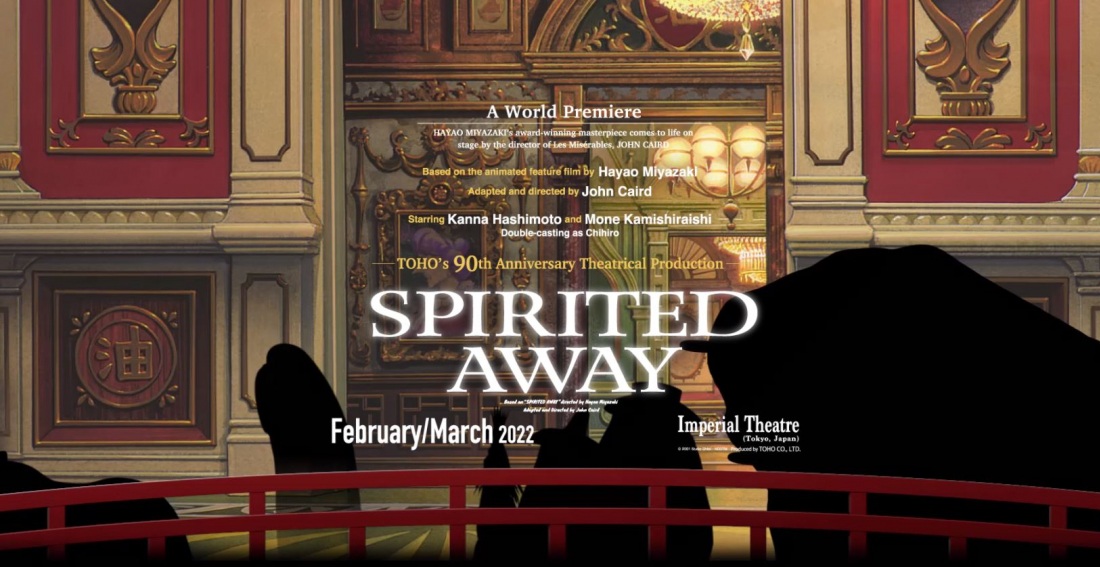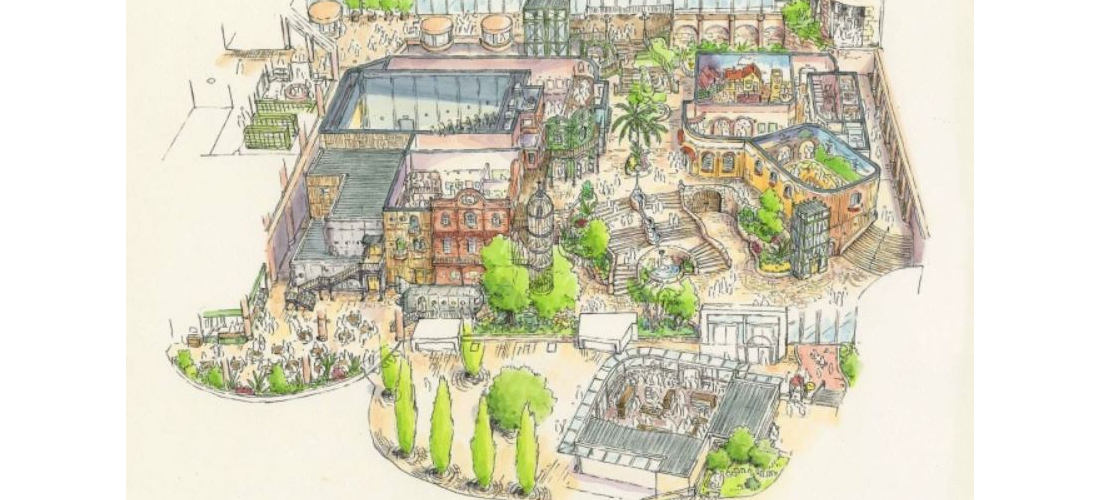For Ghibli fans and theater lovers, this live stage adaption of Spirited Away might be a dream come true.
Have you ever wished you could meet Chihiro (or is it Sen?), Haku, Yubaba, Lin, and all the rest of the bathhouse staff the rest in person? Are you such a Studio Ghibli fan that you might even risk an encounter with a hungry No Face? Well, this might be your chance. Spirited Away blew away box office records when it hit theaters almost 20 years ago, and now it's back in a whole new way, as a live theater performance. The Hayao Miyazaki classic will be premiering on stage directed by John Caird, first at Tokyo's Imperial Theatre in February/March 2022, before moving to productions in Osaka, Fukuoka, Sapporo, and Nagoya later in the year.
【期待】『千と千尋の神隠し』初舞台化!千尋役は橋本環奈&上白石萌音のWキャストhttps://t.co/gj03QJ9brD
スタジオジブリの名作アニメ映画『千と千尋の神隠し』が来年2月、東宝創立90周年記念作品として初めて舞台化されることになった。 pic.twitter.com/Gma5Dd2OGK
— ライブドアニュース (@livedoornews) February 25, 2021
The next most important information, of course, is just who will be playing these beloved characters? Who could really bring the feelings of ten-year-old Chihiro―lost and afraid, but bravely determined―to life? The answer seems to be two different actresses, actually! Spirited Away is being double-cast (or "w-cast" as they might say in Japan), which is fairly common practice for live theater in Japan. Neither actress is an understudy for the other, and they share the role equally, simply splitting dates and times, as do every pair of actors playing each major role.
For Chihiro, the two actresses are Kanna Hashimoto, an idol-turned-actress, and Mone Kamishiraishi, who gained fame as the voice of the lead in the Makoto Shinkai anime film Your Name, and has actually worked with director John Caird before during her career in musical theater. At 22 and 23-years-old respectively, we can only hope the talented young actors will be able to capture Chihiro's young, stubborn spirit.
2人のハク役、初対面です!
ハクのステンドグラスをバックに✨#醍醐虎汰朗 #三浦宏規#ジブリ美術館#千と千尋の神隠し
2022年2・3月、帝国劇場で舞台版世界初演!https://t.co/1YSRP4Eq5i pic.twitter.com/u0QzA3et1M— 舞台『千と千尋の神隠し』 (@sentochihiro_st) July 9, 2021
The two actors playing Haku, seen here meeting for the first time, are Kotaro Daigo and Hiroki Miura. Like Mone Kamishiraishi, Daigo also found popularity after playing a leading role in a Makoto Shinkai anime, although he starred in the more recent film Weathering with You. Miura, despite being just 22 years of age, is already a seasoned musical theater performer, recently appearing in shows like Grease, Little Shop of Horrors, and Les Miserables.
舞台『#千と千尋の神隠し』
メインキャスト発表✨
多彩なキャリア、帝劇に新たな風を巻き起こすキャストが集まりました!#橋本環奈 #上白石萌音 #醍醐虎汰朗 #三浦宏規 #菅原小春 #辻本知彦 #咲妃みゆ #妃海風 #田口トモロヲ #橋本さとし #夏木マリ #朴璐美 pic.twitter.com/WeCYQK4k3g— 舞台『千と千尋の神隠し』 (@sentochihiro_st) July 7, 2021
The rest of the main cast includes a number of performers with illustrious backgrounds. Lin will be played by two particularly popular actresses hailing from the Takarazuka Revue, a famous all-female theater troupe, namely Fu Hinami and Miyu Sakihi. No Face, on the other hand, is being portrayed by choreographer Koharu Sugawara and Cirque du Soleil performer Tomohiko Tsujimoto, who both have extensive backgrounds in dance, hopefully lending No Face all the creepy forms of movement necessary. Satoshi Hashimoto and Tomorowo Taguchi will be splitting the role of Kamaji, the grumpy but endearing many-legged boiler room worker who begrudgingly welcomes Chihiro into the bathhouse. And finally, Yubaba and Zeniba will be played by two actresses sure to excite anime fans everywhere. Romi Park has previously voiced a whole host of characters in internationally famous animes, ranging from her role as Edward Elric himself in Fullmetal Alchemist, to characters in Bleach, Naruto, Attack on Titan, Nana, and even Pokemon (she actually voices Zoroark). Mari Natsuki, on the other hand, has performed far fewer voices, but she did have one extremely important role: the original voice of Yubaba and Zeniba in Spirited Away. And here she is, back to reprise the role, in person this time.
With a little over half a year to go until Spirited Away performances begin, 12 actors playing 6 main characters have been announced, but we're excited to see what else comes out in the remaining months. Will Bo, Yubaba's giant baby and sometimes chubby mouse, maintain his important role in the live stage performance―how might they portray this unusual role? Will the bathhouse's greedy gold-loving frog make it into the play? How about the radish spirit who joins Chihiro in the elevator? (Probably not.) Hopefully the Spirited Away stage play Twitter account will continue to post more about what's coming soon, because as big Ghibli fans, we're waiting in anticipation!
For more info and updates from Japan, check Japankuru for new articles, and don't forget to follow us on Twitter, Instagram, and Facebook!
The latest news from Japan - learn what's new in the land of the rising sun, from an international group right on the scene.
COMMENT
FEATURED MEDIA
VIEW MORE 
A New Tokyo Animal Destination: Relax & Learn About the World’s Animals in Japan
#pr #japankuru #anitouch #anitouchtokyodome #capybara #capybaracafe #animalcafe #tokyotrip #japantrip #카피바라 #애니터치 #아이와가볼만한곳 #도쿄여행 #가족여행 #東京旅遊 #東京親子景點 #日本動物互動體驗 #水豚泡澡 #東京巨蛋城 #เที่ยวญี่ปุ่น2025 #ที่เที่ยวครอบครัว #สวนสัตว์ในร่ม #TokyoDomeCity #anitouchtokyodome

Shohei Ohtani Collab Developed Products & Other Japanese Drugstore Recommendations From Kowa
#pr #japankuru
#kowa #syncronkowa #japanshopping #preworkout #postworkout #tokyoshopping #japantrip #일본쇼핑 #일본이온음료 #오타니 #오타니쇼헤이 #코와 #興和 #日本必買 #日本旅遊 #運動補充能量 #運動飲品 #ช้อปปิ้งญี่ปุ่น #เครื่องดื่มออกกำลังกาย #นักกีฬา #ผลิตภัณฑ์ญี่ปุ่น #อาหารเสริมญี่ปุ่น

도쿄 근교 당일치기 여행 추천! 작은 에도라 불리는 ‘가와고에’
세이부 ‘가와고에 패스(디지털)’ 하나면 편리하게 이동 + 가성비까지 완벽하게! 필름카메라 감성 가득한 레트로 거리 길거리 먹방부터 귀여움 끝판왕 핫플&포토 스폿까지 총집합!
Looking for day trips from Tokyo? Try Kawagoe, AKA Little Edo!
Use the SEIBU KAWAGOE PASS (Digital) for easy, affordable transportation!
Check out the historic streets of Kawagoe for some great street food and plenty of picturesque retro photo ops.
#pr #japankuru #도쿄근교여행 #가와고에 #가와고에패스 #세이부패스 #기모노체험 #가와고에여행 #도쿄여행코스 #도쿄근교당일치기 #세이부가와고에패스
#tokyotrip #kawagoe #tokyodaytrip #seibukawagoepass #kimono #japantrip

Hirakata Park, Osaka: Enjoy the Classic Japanese Theme Park Experience!
#pr #japankuru #hirakatapark #amusementpark #japantrip #osakatrip #familytrip #rollercoaster #retrôvibes #枚方公園 #大阪旅遊 #關西私房景點 #日本親子旅行 #日本遊樂園 #木造雲霄飛車 #히라카타파크 #สวนสนุกฮิราคาตะพาร์ค

🍵Love Matcha? Upgrade Your Matcha Experience With Tsujiri!
・160년 전통 일본 말차 브랜드 츠지리에서 말차 덕후들이 픽한 인기템만 골라봤어요
・抹茶控的天堂!甜點、餅乾、飲品一次滿足,連伴手禮都幫你列好清單了
・ส่องมัทฉะสุดฮิต พร้อมพาเที่ยวร้านดังในอุจิ เกียวโต
#pr #japankuru #matcha #matchalover #uji #kyoto #japantrip #ujimatcha #matchalatte #matchasweets #tsujiri #말차 #말차덕후 #츠지리 #교토여행 #말차라떼 #辻利抹茶 #抹茶控 #日本抹茶 #宇治 #宇治抹茶 #日本伴手禮 #抹茶拿鐵 #抹茶甜點 #มัทฉะ #ของฝากญี่ปุ่น #ชาเขียวญี่ปุ่น #ซึจิริ #เกียวโต

・What Is Nenaito? And How Does This Sleep Care Supplement Work?
・你的睡眠保健品——認識「睡眠茶氨酸錠」
・수면 케어 서플리먼트 ‘네나이토’란?
・ผลิตภัณฑ์เสริมอาหารดูแลการนอน “Nenaito(ネナイト)” คืออะไร?
#pr #japankuru #sleepcare #japanshopping #nenaito #sleepsupplement #asahi #睡眠茶氨酸錠 #睡眠保健 #朝日 #l茶胺酸 #日本藥妝 #日本必買 #일본쇼핑 #수면 #건강하자 #네나이토 #일본영양제 #อาหารเสริมญี่ปุ่น #ช้อปปิ้งญี่ปุ่น #ร้านขายยาญี่ปุ่น #ดูแลตัวเองก่อนนอน #อาซาฮิ

Japanese Drugstore Must-Buys! Essential Items from Hisamitsu® Pharmaceutical
#PR #japankuru #hisamitsu #salonpas #feitas #hisamitsupharmaceutical #japanshopping #tokyoshopping #traveltips #japanhaul #japantrip #japantravel

Whether you grew up with Dragon Ball or you just fell in love with Dragon Ball DAIMA, you'll like the newest JINS collab. Shop this limited-edition Dragon Ball accessory collection to find some of the best Dragon Ball merchandise in Japan!
>> Find out more at Japankuru.com! (link in bio)
#japankuru #dragonball #dragonballdaima #animecollab #japanshopping #jins #japaneseglasses #japantravel #animemerch #pr

This month, Japankuru teamed up with @official_korekoko to invite three influencers (originally from Thailand, China, and Taiwan) on a trip to Yokohama. Check out the article (in Chinese) on Japankuru.com for all of their travel tips and photography hints - and look forward to more cool collaborations coming soon!
【橫濱夜散策 x 教你怎麼拍出網美照 📸✨】
每次來日本玩,是不是都會先找旅日網紅的推薦清單?
這次,我們邀請擁有日本豐富旅遊經驗的🇹🇭泰國、🇨🇳中國、🇹🇼台灣網紅,帶你走進夜晚的橫濱!從玩樂路線到拍照技巧,教你怎麼拍出最美的夜景照。那些熟悉的景點,換個視角說不定會有新發現~快跟他們一起出發吧!
#japankuru #橫濱紅磚倉庫 #汽車道 #中華街 #yokohama #japankuru #橫濱紅磚倉庫 #汽車道 #中華街 #yokohama #yokohamaredbrickwarehouse #yokohamachinatown

If you’re a fan of Vivienne Westwood's Japanese designs, and you’re looking forward to shopping in Harajuku this summer, we’ve got important news for you. Vivienne Westwood RED LABEL Laforet Harajuku is now closed for renovations - but the grand reopening is scheduled for July!
>> Find out more at Japankuru.com! (link in bio)
#japankuru #viviennewestwood #harajuku #omotesando #viviennewestwoodredlabel #viviennewestwoodjapan #비비안웨스트우드 #오모테산도 #하라주쿠 #日本購物 #薇薇安魏斯伍德 #日本時尚 #原宿 #表參道 #japantrip #japanshopping #pr

Ready to see TeamLab in Kyoto!? At TeamLab Biovortex Kyoto, the collective is taking their acclaimed immersive art and bringing it to Japan's ancient capital. We can't wait to see it for ourselves this autumn!
>> Find out more at Japankuru.com! (link in bio)
#japankuru #teamlab #teamlabbiovortex #kyoto #kyototrip #japantravel #artnews
Photos courtesy of teamLab, Exhibition view of teamLab Biovortex Kyoto, 2025, Kyoto ® teamLab, courtesy Pace Gallery

Japanese Makeup Shopping • A Trip to Kamakura & Enoshima With Canmake’s Cool-Toned Summer Makeup
#pr #canmake #enoshima #enoden #에노시마 #캔메이크 #japanesemakeup #japanesecosmetics

⚔️The Robot Restaurant is gone, but the Samurai Restaurant is here to take its place. Check it out, and don't forget your coupon!
🍣신주쿠의 명소 로봇 레스토랑이 사무라이 레스토랑으로 부활! 절찬 쿠폰 발급중
💃18歲以上才能入場的歌舞秀,和你想的不一樣!拿好優惠券去看看~
#tokyo #shinjuku #samurairestaurant #robotrestaurant #tokyotrip #도쿄여행 #신주쿠 #사무라이레스토랑 #이색체험 #할인이벤트 #歌舞伎町 #東京景點 #武士餐廳 #日本表演 #日本文化體驗 #japankuru #japantrip #japantravel #japanlovers #japan_of_insta

Japanese appliance & electronics shopping with our KOJIMA x BicCamera coupon!
用JAPANKURU的KOJIMA x BicCamera優惠券買這些正好❤️
코지마 x 빅 카메라 쿠폰으로 일본 가전 제품 쇼핑하기
#pr #japankuru #japanshopping #kojima #biccamera #japaneseskincare #yaman #dji #osmopocket3 #skincaredevice #日本購物 #美容儀 #相機 #雅萌 #日本家電 #일본여행 #면세 #여행꿀팁 #일본쇼핑리스트 #쿠폰 #일본쇼핑 #일본브랜드 #할인 #코지마 #빅카메라 #japankurucoupon



















































